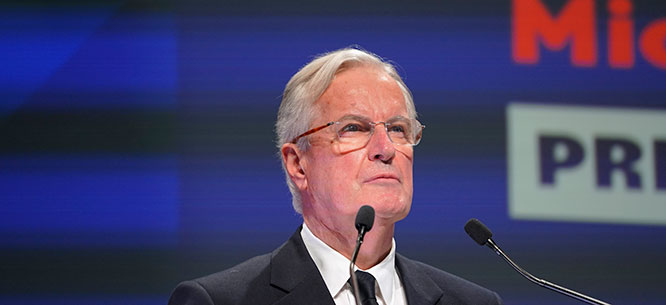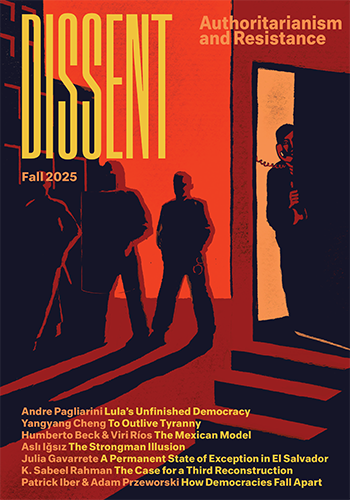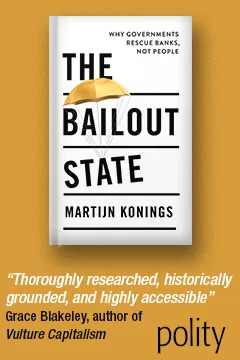What’s Next for the New Popular Front?
What’s Next for the New Popular Front?
The rapid fall of Michel Barnier’s government will test the unity of the French left.

In July the New Popular Front (NFP), a coalition of left-wing parties, came out on top in a snap general election in France, winning 193 seats in the National Assembly. The centrist bloc supporting President Emmanuel Macron got 166 seats, the far-right National Rally (RN) 142, and the center-right Republicans forty-seven.
Three indisputable facts stand out. First, Macron’s governing coalition lost the election. Second, tactical voting and strategic withdrawal of candidates by Macronists and leftists in the decisive second round prevented the RN from winning altogether after it gained the most votes in the first round. This “republican front” strategy worked beyond all expectations: despite receiving the most votes of any party, the RN came third in terms of seats. Finally, the election resulted in a hung parliament and created a political conundrum. The NFP won the most seats in the National Assembly but was left almost 100 short of an absolute majority.
With limited room for maneuver, the NFP put forth Lucie Castets, a civil servant, as candidate for prime minister. In August Macron rejected her nomination on the grounds that her government would have succumbed to an immediate motion of no confidence. This was a contentious interpretation of the president’s constitutional powers. Whether an NFP government would have been rapidly censured or imploded when forced to compromise is irrelevant. Citizens who cast their vote to defeat the far right deserved to find out.
The truth is that Macron did not want his pension reform to be undone, so he turned to the right and appointed Michel Barnier, the former chief Brexit negotiator for the European Union. Barnier is a member of the Republicans, a party that received a paltry 5.4 percent of the vote and refused to participate in the republican front strategy. The minority government he led had no political legitimacy, no unity, and no real purpose apart from keeping the left out of office.
In October, Barnier presented his government’s budget bill for 2025, which aimed to bring the public deficit from 6.1 percent of GDP to 5 percent. It included tax increases and €40 billion in spending cuts, half of which would come from the state budget, the rest from social security and local authorities. Without a majority in the National Assembly to move the bill forward, Barnier had to use Article 49.3 of the Constitution, which enables the prime minister to pass legislation without a vote. The left had no other choice but to bring a motion of no confidence. Despite Barnier accepting key budget demands from the RN, Marine Le Pen decided to vote with the left to censure the government on December 4. This was the first successful motion of no confidence since 1962, and Barnier was the shortest-serving prime minister since the beginning of the Fifth Republic in 1958.
The day after the fall of Barnier’s government, Macron went on the air to say that he would stay in power until the end of his term in 2027 and would appoint a new prime minister shortly. This gave the left another chance to form a government or, at least, join a coalition. Last summer, the left was understandably outraged at not being considered for office after it had won the biggest bloc in the National Assembly. Jean-Luc Mélenchon, the leader of La France Insoumise (LFI, the most radical party in the NFP coalition), declared that Macron “stole” the election and called for the president’s impeachment. Yet the NFP remained stuck in opposition.
There are three possibilities for what might happen next. The first is an NFP government. This is the least likely scenario, as Macron remains deeply opposed to the left’s goals. And how would a left government pass progressive legislation when 70 percent of MPs are conservative if not far right? This is a hard question the NFP has no answer for. The second is the appointment of a Barnier 2.0 to lead a coalition of Macronists and Republicans. Such an appointment could only exacerbate popular anger and would inevitably lead to another vote of no confidence, something Macron cannot afford.
Third, there could be a coalition government led by a center-left figure. Olivier Faure, the leader of the Socialist Party (PS), has alluded to the appointment of a left-wing prime minister open to compromise with the right. He or she would be committed to governing without using Article 49.3 in return for immunity from a motion of no confidence. There is one problem here: some in the PS would agree to a coalition government, but LFI would reject it. This would provoke major tensions between NFP partners and could even split the coalition.
The combined number of Socialist and Macronist MPs (including Macron’s centrist allies) would total 252—still short of an absolute majority (289). But this new minority government could work if the Republicans abstain from voting against the new coalition; LFI and RN together would not have enough votes to bring down the government. The PS would only join such a coalition government if enough Green and Communist MPs came on board too; the Socialists do not want to be seen as the force that wrecked the NFP. This messy and quite improbable scenario might be the left’s best shot right now for political influence.
A United Left
The NFP was launched on June 13 following Macron’s dissolution of the National Assembly. It is comprised of the four main parties of the French left: the PS, the Ecologists, the Communist Party (PCF), and LFI. It is an electoral alliance akin to the New Ecological and Social People’s Union (NUPES), which formed in May 2022 in the run-up to legislative elections and imploded in October 2023 after LFI refused to categorize Hamas as a terrorist organization.
The NFP required its candidates to support a radical social democratic platform: scrap Macron’s pension reform law, which raised the retirement age from sixty-two to sixty-four; increase the minimum wage and public-sector salaries; freeze the price of basic food items and energy; and, to fund it all, introduce a wealth tax and hike income taxes for the highest earners.
The NUPES and NFP coalitions were made possible, in part, by the Socialists’ recent turn to the left. Once a dominant political force, the PS suffered a crushing defeat in the 2017 presidential election when a large chunk of Socialist voters abandoned the party for either Macron or Mélenchon. In response, Olivier Faure has distanced himself from the presidency of François Hollande, which was marked by a steady drift to the right on the economy and law-and-order issues. The change has proved beneficial: at the European elections last June, the PS received the most votes of all left-wing parties, and in July it doubled its number of MPs in the National Assembly.
This relative Socialist surge has come as Mélenchon’s popularity has plummeted. Two years ago, NUPES rallied behind the LFI leader for prime minister, but this time the party’s partners firmly rejected his candidacy. We may be witnessing something similar to what happened with François Mitterrand’s PS half a century ago. In 1972 the party pursued an electoral agreement with the PCF, then the dominant party on the left; by the legislative elections of 1978, the PS had obtained more votes than the Communists. Mitterrand’s strategy worked according to plan: in a union of the left, voters ended up preferring the more moderate party.
Despite coming out on top in the recent election, the left remains a minority force. Opinion polls and academic research show that France is more liberal and more tolerant than it used to be on issues such as immigration, sexuality, gender equality, and the death penalty. Yet this trend has not translated to support for the left at the ballot box. On the contrary, its power has declined. In the first round of the 2012 presidential election, left-wing candidates together received 44 percent of the vote share. In 2022, that number was down to 32 percent. Despite being in opposition for the past seven years, the left is showing no sign of electoral recovery. In the 2024 legislative elections, the four parties of the NFP secured 28.1 percent of the votes in the first round and 25.7 percent in the second round. Compare those figures with the 33.2 percent for the RN in the first round and 37 percent in the second round. With under one-third of the votes, the united left is truly a minority bloc.
What is more, support for the RN surpasses support for the left across social categories. A study published after the 2024 European and legislative elections shows that 23 percent of private-sector employees voted for the NFP in the legislative elections, while 42 percent voted for the RN. Twenty-two percent of blue-collar workers voted for the NFP and 41 percent for the RN. A large fraction of workers does not vote, but it remains to be seen whether this group’s electoral participation would boost the share of votes for the left. The RN has also recently started to fare well with white-collar professions. And among public-sector workers (a traditional bastion of the left), only teachers still favor the left. Thirty-six percent of public-sector workers voted for the RN and 25 percent for the NFP—a worrying trend for a left that traditionally champions public services. Opinion polls have shown that there is popular demand for these services, but a majority of voters does not seem to trust the left to improve or modernize them.
The Mélenchon Problem
Mélenchon was a PS member and a party official from 1976 to 2008 and served as a minister in the Lionel Jospin government. Mitterrand’s most indefatigable advocate, Mélenchon is at heart a left nationalist, inspired by the values of French republicanism. On social and economic issues, he is a social democrat. Widely regarded today as a far-left politician, his rhetorical radicalism is part of a strategy to take advantage of the electoral space opened by the PS’s steady shift to the right. After three impressive presidential campaigns, Mélenchon’s popularity seems to be waning. But he still maintains tight control over the politics of the left.
Mélenchon is the self-appointed leader of LFI, a movement whose members have no power to elect its governing bodies or dissent from major decisions, which he makes on his own. LFI members who have recently denounced the absence of internal democracy have faced harsh consequences. In the run-up to the 2024 legislative election, several high-profile MPs departed or were purged from the movement after making critical comments—notably Alexis Corbière and Raquel Garrido, two historic allies from Mélenchon’s PS years; Clémentine Autain, a feminist and radical left figure; and François Ruffin, a well-known journalist who was elected as an MP in a white working-class area of northern France.
Since 2008 Mélenchon has attempted to unite the disparate parts of the radical left by bringing them into electoral coalitions. In 2016 he adopted a populist strategy, rooted in a theory of cleavage between the people and the elite. Today Mélenchon’s anti-system rhetoric, as many have noted, has similarities to the repertoire of the far right. Unlike the RN, LFI combats racism and promotes social reforms for the many. But both parties use the same hyperbolic language against “the elites,” demonize political personalities (usually Macron), stir up popular resentment, entertain conspiracy theories (anti-vax sentiments ran high in both LFI and the RN during the COVID-19 pandemic), and oppose NATO in the name of the fight against U.S. imperialism.
By using antagonizing and, at times, abusive rhetoric against political opponents and the media, Mélenchon has mobilized some who had given up on politics, including the young, the working class, and ethnic minorities. Yet so far these tactics have not benefited the left electorally. Most voters regard LFI as a “far-left” movement, and its uncompromising approach is a constant source of tension with its left-wing allies. Mélenchon’s base is small and doesn’t seem to be growing. It’s hard to imagine how he could ever win a direct election against Marine Le Pen, whose RN has only grown in popularity and mainstream respectability.
A Missing Narrative
On election night in July, Mélenchon declared that the left should govern and implement “all of its program”—an impossibility given that the NFP is almost 100 seats short of an absolute majority. Similar political delusion reigned throughout the process to select a new prime minister. The NFP spent a lot of time fighting over a candidate, seemingly oblivious to the fact that it also had to build ad hoc majorities with elements outside the coalition. (Lucie Castets alluded to contacts being made with opponents, and that she was willing to “compromise,” but it all remained vague.)
When it became clear that Macron would not appoint Castets, the names of two center-left candidates were floated by their supporters and the media. One was Bernard Cazeneuve, a former Socialist prime minister. The other was Karim Bouamrane, the young Socialist mayor of Saint-Ouen, a city with an ethnically diverse population on the outskirts of Paris. We do not know whether Macron would have appointed either candidate, but both men were available and were ready to form a coalition government. NFP leaders rejected both names on the grounds that it would undermine left unity and reiterated their support for Castets. In truth, LFI considered both men too “right-wing,” and the PS obliged. While Macron did not need an excuse to turn to the right and appoint Michel Barnier, Mélenchon made it easier for him to do so.
Now that the Barnier government has dissolved, the left may once again appear as an untested alternative. However, the Barnier experiment has shown that no minority government can survive for long. If parts of the left decide to enter a coalition government with the Republicans and Macron’s party, it would represent a major political challenge to the NFP. Whatever the outcome, the left will remain in a weak position, without enough clout to dictate the political tempo.
The NFP, above all a coalition to avert an electoral debacle, has an ambitious social democratic program. The trouble is that it has no unifying narrative. The RN has one that is proving increasingly attractive to French voters from all backgrounds. It divides French society into two opposed classes: On the one hand there are the “producers,” who earn a living through their hard work and pay taxes. On the other are the “parasites,” made up of both the transnational economic elites who thrive on globalization and the “illegitimate recipients” of wealth redistribution and social benefits (migrants, foreigners, Muslims). This narrative enables the RN to position itself as the party that allegedly supports the “hard-working French folk,” as the philosopher Michel Feher has put it, against the exploitative wealthy and the undeserving poor. The attack on national elites and supranational institutions (such as the European Union) makes the RN look like the party of the underdogs, while attacks on migrants and foreigners give voters someone to blame for their problems. The RN is increasingly regarded as the only party that cares about upstanding French citizens.
By contrast, the left puts forward a catalog of policy proposals but fails to articulate an emancipatory narrative. The left’s problem is not its lack of unity or good ideas. It never was and probably never will be united. Its policies are about as good as it gets in the current circumstances. Its weakness is of a different nature. Its leaders are either disliked by most of the electorate (Mélenchon) or dull (all the others).
It is time to retire abstract pledges to “break with capitalism”—an idea that is meaningless to most voters—and instead fight for concrete forms of freedom in the workplace and with regard to life choices. And while the millions who vote for the RN may be motivated by racism, to give up on white working-class or public-sector voters is no solution. It was not long ago that these voters supported the left.
The NFP must come up with a progressive narrative that unifies the working and middle classes in urban and rural areas. This is not an easy task. It requires reengaging with people locally through trade unions and associations and getting beyond social media. To achieve this goal, the left needs a dominant party—a broad church—that can encompass various political traditions, like Mitterrand’s PS did in 1971. This party should be democratic, pluralist, and bring together radicals and moderates, the “old left” as well as feminists and environmentalists. Its center of gravity should be social democratic. Hyperbolic left-wing language and constant agitprop appeal to the faithful, but they are off-putting for most voters.
The French electorate is disoriented and angry. The left must understand and react to this negative zeitgeist accordingly. It must stay true to its principles and offer a political alternative to Macronism, and it will not be easy to achieve this in a coalition government—but left-wing campism or sectarianism will not help either. Only a no-nonsense left, pragmatic and resolute, can make a difference. Antonio Gramsci’s overused quote rings so true in the current circumstances: “The old is dying and the new cannot be born; in this interregnum, a great variety of morbid symptoms appear.” This is the situation of the French left encapsulated.
Philippe Marlière is a professor of French and European politics at University College London. He researches the French left, the RN, and political ideas. He is currently writing a book on the mainstreaming of far-right ideas in France (to be published by Routledge).






